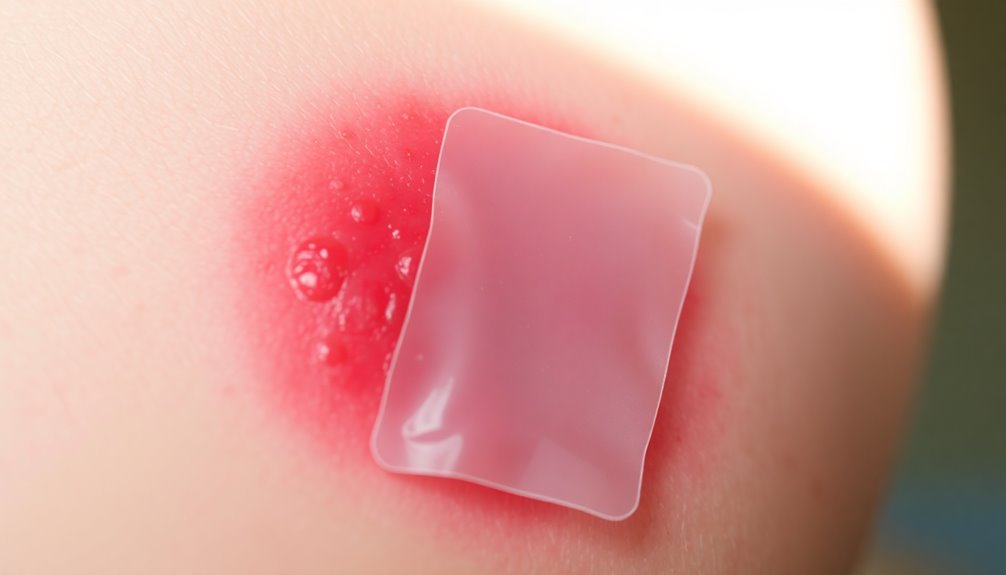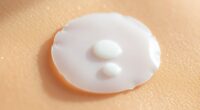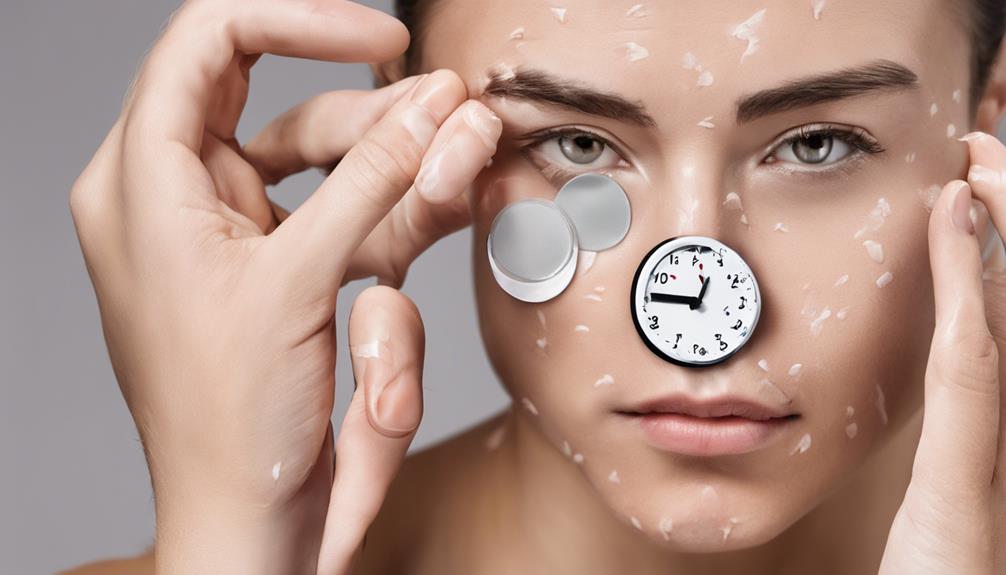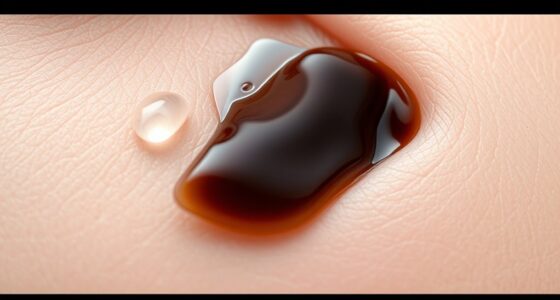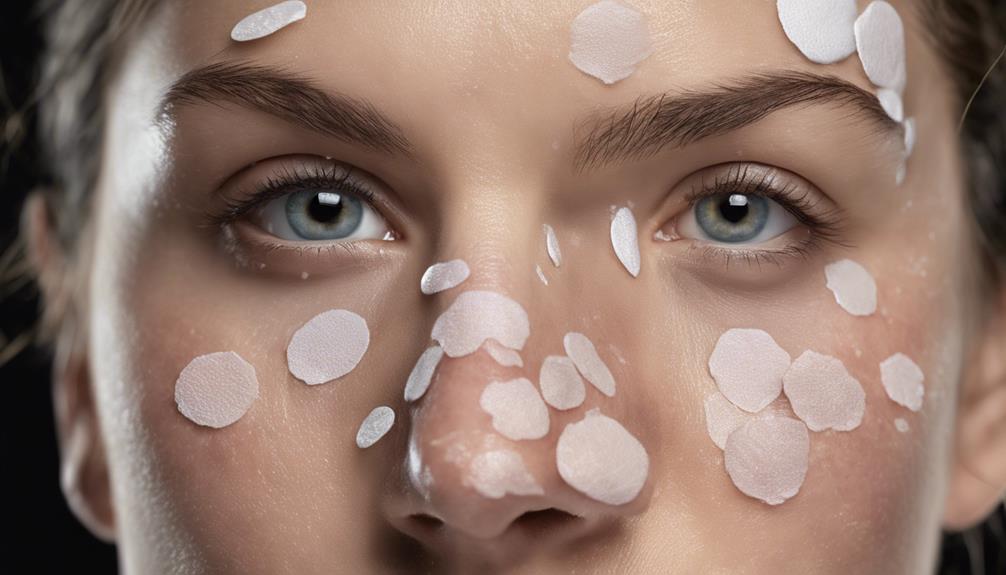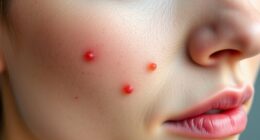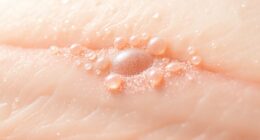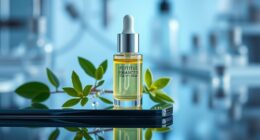Yes, pimple patches do work on popped pimples! They create a protective barrier that absorbs excess fluid and helps heal the skin. By keeping the area moist, they minimize scarring and reduce inflammation, promoting faster recovery. It's important to apply them correctly for the best results. If you want to know more about the types of patches and how to use them effectively, you might just find some useful tips ahead.
Key Takeaways
- Pimple patches create a protective barrier over popped pimples, absorbing excess fluid and preventing infection.
- They maintain a moist environment that promotes faster healing and reduces scarring.
- Hydrocolloid patches are particularly effective for cystic acne and popped pimples.
- Active ingredients like salicylic acid and tea tree oil enhance the patches' effectiveness against inflammation and bacteria.
- Proper application techniques maximize benefits and minimize complications when using patches on popped pimples.
Understanding Pimple Patches

Pimple patches are a practical solution for treating acne, especially after you've popped a pimple. These adhesive stickers, made primarily from hydrocolloid material, work wonders by absorbing excess fluid, oil, and dirt from the affected area. Many effective pimple patches are designed for cystic acne treatment, which can help with stubborn breakouts.
When you apply a pimple patch to a popped pimple, it not only provides a protective barrier against bacteria and dirt but also helps speed up the healing process. Many pimple patches come infused with active ingredients like salicylic acid and tea tree oil, which target acne-causing bacteria and reduce inflammation. Using essential oils such as tea tree oil can enhance the effectiveness of your pimple patch treatment.
While pimple patches can be effective, remember that their success often depends on the type and severity of your acne, yielding the best results on surface-level lesions like pustules and papules. Following a proper routine can maximize the benefits of the patches, as they are recommended to be used before other skincare products.
How Pimple Patches Function on Popped Pimples

When you've popped a pimple, using a pimple patch can greatly aid in the healing process.
These patches, especially hydrocolloid types, work by creating a protective barrier over the affected area.
Here's how they help:
- Absorb excess sebum and pus
- Maintain a moist environment for healing
- Shield the area from bacteria and irritants
- Prevent scarring by minimizing irritation
- Enhance healing with active ingredients in micro-vector patches
Additionally, these patches can support personalized learning experiences by providing tailored treatments that cater to individual skin types and needs. This is particularly beneficial because hydrocolloid technology promotes healing by drawing out impurities effectively.
Types of Pimple Patches
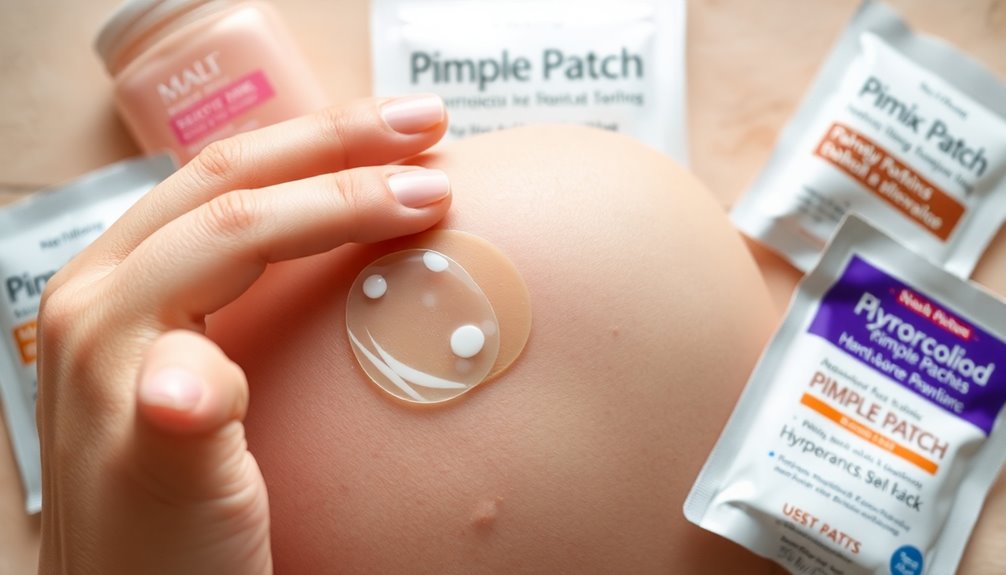
When it comes to pimple patches, you've got a few solid options to contemplate.
Hydrocolloid patches work wonders for absorbing fluid and protecting your skin, while microneedle patches target deeper layers for effective treatment.
Plus, medicated patches can give your skin an extra boost with active ingredients like salicylic acid to tackle breakouts more efficiently. Additionally, using patches infused with essential oils for skin health may provide added benefits such as soothing inflammation and promoting healing.
Hydrocolloid Patch Benefits
Hydrocolloid patches offer a range of benefits for treating popped pimples, making them a go-to solution for many.
These patches are designed to absorb excess fluid and oil, promoting faster healing while reducing inflammation. By creating a protective barrier over the area, hydrocolloid patches prevent bacteria from entering and causing further irritation, which is crucial given that bacterial infection risk can exacerbate skin issues.
You'll notice that they turn opaque as they effectively draw out impurities, indicating they're working hard.
- Absorb excess fluid and dirt
- Promote faster healing
- Reduce inflammation
- Minimize scarring
- Protect against bacteria
Using hydrocolloid patches on popped pimples helps keep the area moist and protected, ensuring ideal healing results. They're particularly effective for superficial, inflamed acne lesions, making them a valuable addition to your skincare routine. Additionally, their ability to create a protective barrier helps prevent further irritation and supports the healing process.
Microneedle Patch Advantages
Microneedle patches offer a unique approach to acne treatment by delivering active ingredients directly into the skin, making them particularly effective for early-stage acne and post-inflammatory hyperpigmentation.
These patches contain over 150 tiny microneedles that dissolve upon application, targeting blind pimples and dark spots. The ability to penetrate deeper layers allows microneedle patches to address various acne types, including those not yet visible on the surface. Incorporating foods rich in omega-3 fatty acids can also support skin health and reduce inflammation.
With beneficial ingredients like vitamin C and tranexamic acid, they brighten skin and reduce dark spots. Their pyramid design enhances ingredient delivery and absorption, making them considerably more effective than traditional flat patches. Additionally, the use of dietary fiber in the diet can support overall skin health by promoting gut microbiota balance, which may help reduce inflammation.
If you're looking for targeted treatment, microneedle patches may be the solution you need.
Medicated Patch Options
Choosing the right type of pimple patch can greatly impact your acne treatment journey.
Medicated patches come in various types, each designed to target specific issues. Here are some options to evaluate:
- Hydrocolloid patches: Absorb excess fluid and create a protective barrier, perfect for popped pimples.
- Salicylic acid patches: Help exfoliate and reduce inflammation, aiding in healing.
- Tea tree oil patches: Offer natural antibacterial properties for acne-prone skin.
- Microneedle patches: Deliver active ingredients directly into the skin for early-stage acne.
- Brand-specific options: Various brands like COSRX and Hero Cosmetics provide different sizes for different pimple types.
Choosing the right medicated patch based on your pimple's stage can enhance healing and minimize scarring. Additionally, incorporating products with glycolic acid may further assist in reducing inflammation and promoting skin clarity.
Key Ingredients in Pimple Patches
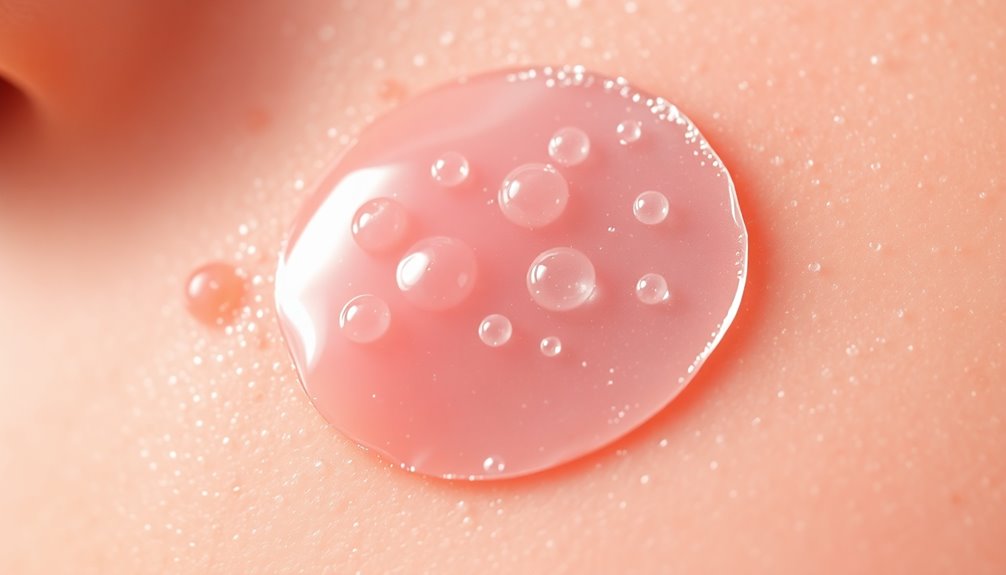
When dealing with popped pimples, understanding the key ingredients in pimple patches can make a significant difference in your healing process. Most patches are made from hydrocolloid material, which helps absorb excess fluid and creates a barrier against bacteria. Active ingredients like salicylic acid exfoliate the skin and unclog pores, promoting faster healing. Tea tree oil, often included, has antibacterial properties that reduce inflammation and soothe irritated skin.
| Ingredient | Benefit |
|---|---|
| Hydrocolloid | Absorbs excess fluid |
| Salicylic Acid | Exfoliates and unclogs pores |
| Tea Tree Oil | Antibacterial and anti-inflammatory |
| Microneedles | Delivers concentrated active ingredients |
These elements work together to effectively target the infected area.
Benefits of Using Pimple Patches on Popped Pimples
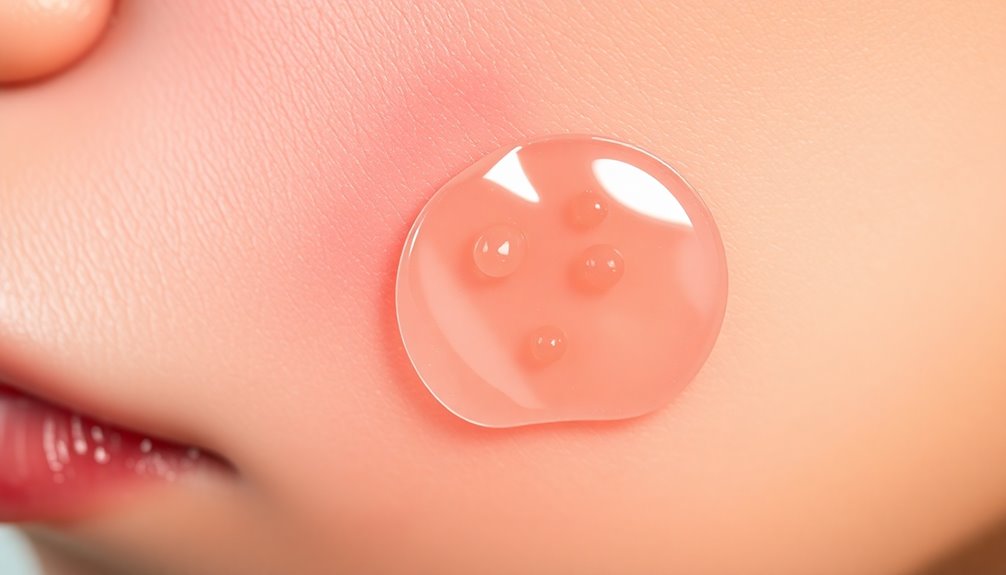
Using pimple patches on popped pimples offers several benefits that can greatly enhance your healing process.
These patches help absorb excess fluids and protect the area, markedly reducing the risk of infection. Here are some key advantages:
- Promote faster healing with a moist environment
- Reduce inflammation and redness for a better appearance
- Contain active ingredients like salicylic acid or tea tree oil for effective treatment
- Prevent infection by shielding the area from bacteria
- Deter you from picking at the blemish, which can worsen the situation
Common Mistakes to Avoid When Using Pimple Patches
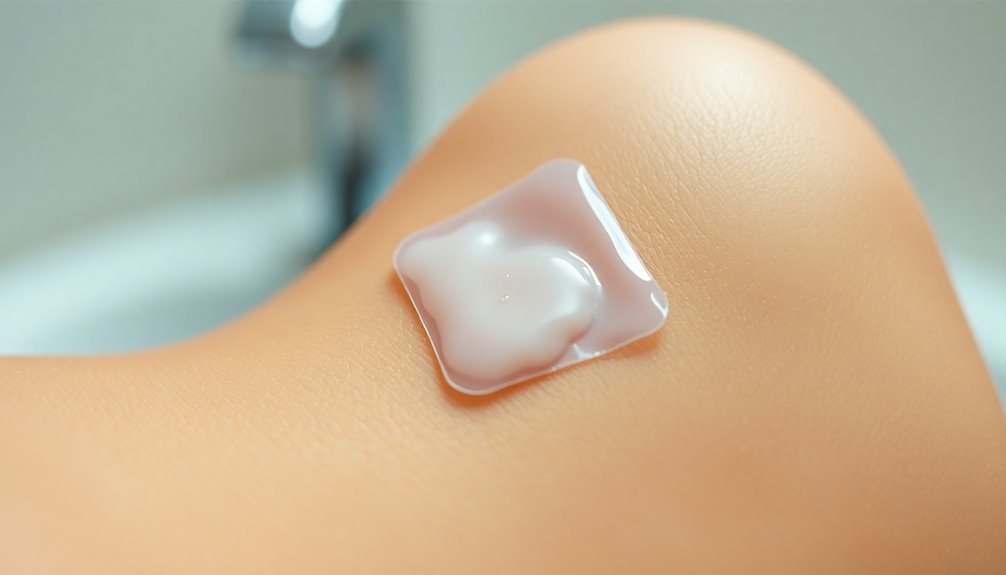
While pimple patches can greatly aid in the healing of popped pimples, there are some common mistakes that can undermine their effectiveness.
First, make sure to cleanse the area and your hands before applying patches; this helps prevent bacteria from causing infection.
Always cleanse your hands and the affected area before applying pimple patches to prevent infections.
Avoid using patches on non-inflamed or early-stage pimples, as they work best on already popped spots.
Also, don't apply them on wet or oily skin, which can hinder adhesion.
Remember, leaving patches on for longer than 24 hours can lead to skin irritation.
Finally, don't expect pimple patches to treat deep or severe acne; they're designed for surface-level pimples.
Proper Application Techniques for Pimple Patches

Applying pimple patches correctly can make all the difference in your skin's healing process. Follow these proper application techniques to maximize effectiveness:
- Clean the area and your hands thoroughly to reduce infection risk.
- Choose a hydrocolloid patch to absorb excess fluid and protect the healing area.
- Press the patch firmly onto the popped pimple, ensuring no air bubbles are trapped underneath.
- Leave the patch on for at least six hours, or until it turns opaque, signaling it's done absorbing.
- After removing the patch, gently cleanse the area again to maintain cleanliness.
Aftercare for Popped Pimples
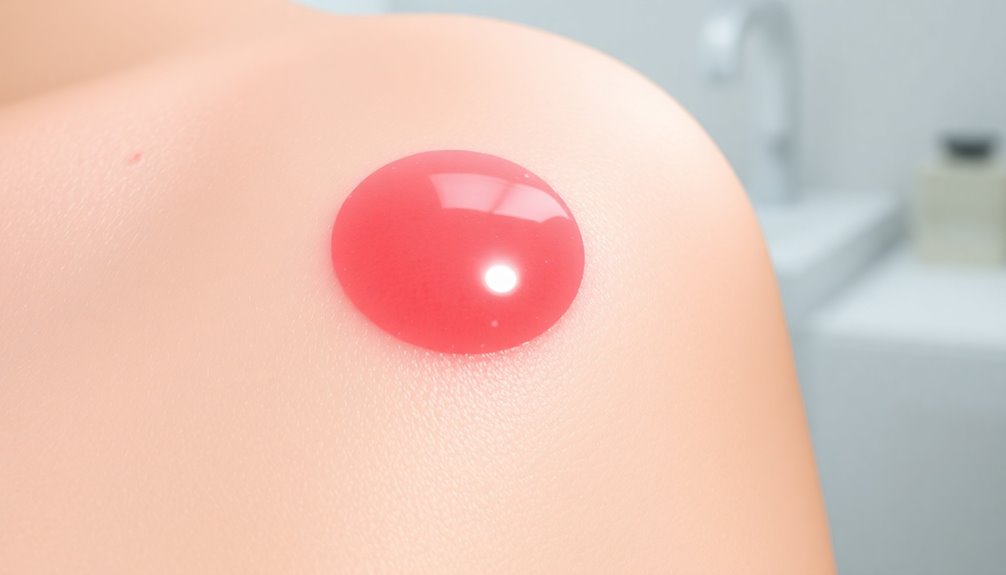
After popping a pimple, keeping the area clean is vital to prevent infection and promote healing. Using hydrocolloid pimple patches can be a game-changer. They help absorb fluids, protect the area, and speed up the healing process. Here's a quick guide on aftercare:
| Action | Purpose | Tips |
|---|---|---|
| Clean the area | Prevent infection | Use a gentle cleanser |
| Apply hydrocolloid patch | Absorb fluids | Change patch as needed |
| Avoid touching the area | Reduce irritation | Keep your hands off |
| Protect from sunlight | Prevent hyperpigmentation | Wear sunscreen or a hat |
| Monitor for infection | guarantee safe healing | Look for redness, swelling, or pus |
Professional Insights on Pimple Patches
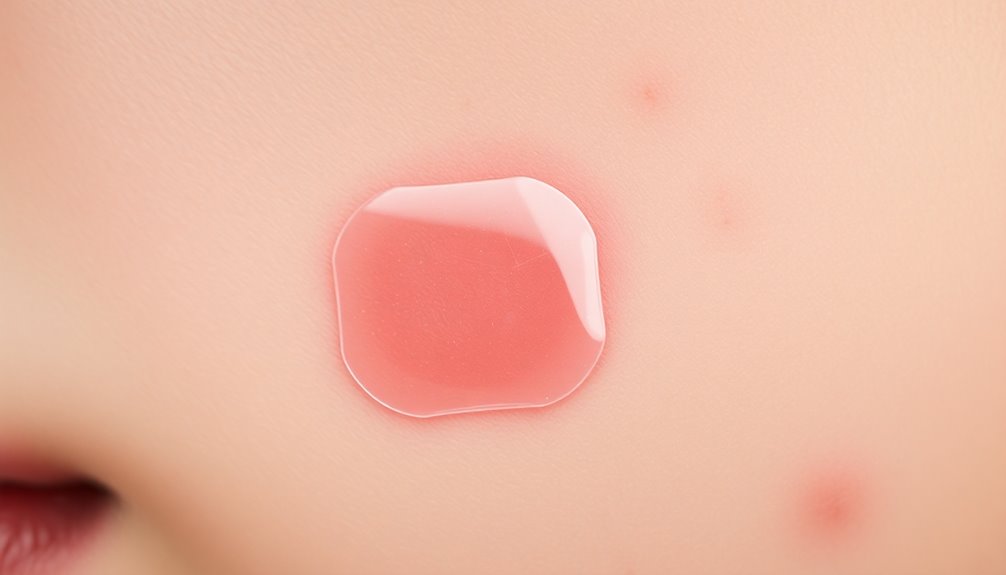
When it comes to healing popped pimples, pimple patches can be a game changer.
Experts emphasize the importance of proper application techniques to maximize their effectiveness and minimize complications.
Let's explore some professional tips that can help you get the best results from these patches.
Efficacy on Healing Pimples
While pimple patches are widely known for their convenience, their efficacy in healing popped pimples is backed by both science and user experience.
These patches, especially hydrocolloid types, work wonders by absorbing excess fluids and creating a protective barrier over the skin. This barrier not only prevents bacterial contamination but also promotes faster healing.
Here are some key benefits of using pimple patches on popped pimples:
- Absorb excess fluids
- Reduce inflammation with active ingredients like salicylic acid
- Prevent secondary infections
- Speed up recovery time
- Minimize the risk of scarring
For the best results, apply a pimple patch as soon as possible after popping a pimple, ensuring you take advantage of their full healing potential.
Recommended Application Techniques
To achieve the best results with pimple patches, you'll want to follow a few key application techniques.
First, make sure you start with a clean area; this maximizes the patch's adhesion and effectiveness.
Once the area is clean and dry, apply the pimple patch directly onto the popped pimple. These hydrocolloid patches are designed to absorb excess fluid while creating a protective barrier against bacteria, aiding in the healing process.
For best absorption, leave the patch on for at least six hours or overnight.
After removing it, gently cleanse the area again to maintain cleanliness and prevent infection.
Expert Tips for Use
Although pimple patches are a popular choice for treating popped pimples, knowing how to maximize their effectiveness can make a significant difference. Here are some expert tips to guarantee you get the most out of your pimple patch:
- Clean the area thoroughly to minimize the risk of infection.
- Choose hydrocolloid patches, as they absorb excess fluid and promote the healing process.
- Leave the pimple patch on for at least six hours for peak results.
- Remove the patch gently and clean the area again to prevent irritation.
- Use patches regularly to protect the area from acne-causing bacteria.
Additional Acne Treatment Options
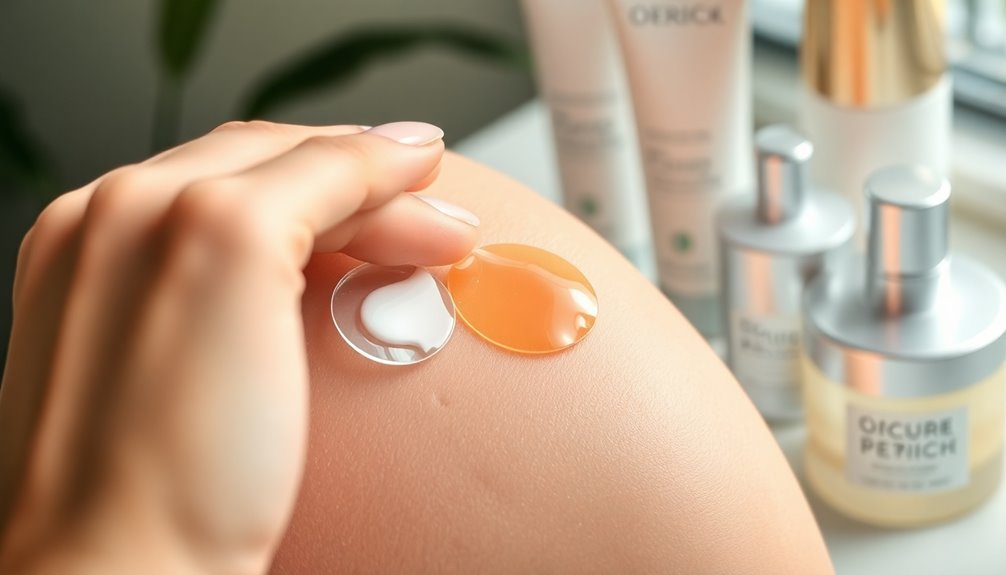
When dealing with popped pimples, you've got several additional acne treatment options that can speed up healing and prevent future breakouts.
Topical treatments like benzoyl peroxide can reduce bacteria and inflammation, while salicylic acid helps unclog pores. These ingredients work well alongside pimple patches for targeted healing.
Don't forget to maintain a consistent skincare routine with gentle cleansers and non-comedogenic moisturizers to support overall skin health.
For more severe cases, consult a dermatologist about professional treatments, such as oral antibiotics or retinoids, which help reduce inflammation.
You might also consider procedures like chemical peels or laser therapy, as they can target deeper acne lesions and improve skin texture, providing you with more extensive acne care options.
Frequently Asked Questions
Can You Put a Pimple Patch on After Popping a Pimple?
Yes, you can definitely put a pimple patch on after popping a pimple.
These patches absorb excess fluids and protect the area from bacteria, helping to speed up healing.
Just make certain you cleanse the area thoroughly before applying the patch to guarantee it sticks well and stays hygienic.
Keep an eye on the popped pimple for any signs of infection, like increased redness or pus, while using the patch.
Can You Put a Pimple Patch on Open Acne?
Yes, you can put a pimple patch on open acne.
These patches help absorb fluid and protect the area from bacteria, which is essential for healing. Make sure the skin is clean and dry before applying the patch to get the best results.
They create a moist environment that promotes healing and reduces inflammation, but remember, they mightn't work for all acne types.
Pairing them with a good skincare routine can enhance effectiveness.
Can I Put a Pimple Patch on a Closed Pimple?
You shouldn't put a pimple patch on a closed pimple.
Pimple patches are designed to target fluid and pus, which isn't present in closed pimples. They work best on popped ones, where they can absorb excess liquid and protect the area.
Using a patch on a closed pimple won't be effective since there's no drainage, and it might just irritate your skin further.
Stick to using patches on pimples with visible heads for best results.
Can You Put a Pimple Patch on an Unopened Pimple?
Imagine a warrior ready to battle an enemy that's still hiding in the shadows. You might think putting a pimple patch on an unopened pimple will help, but it's not your best move.
The patch won't stick well, and it can't tackle the underlying issue. Instead, focus on treating the pimple with salicylic acid or benzoyl peroxide.
Once it's ready for battle, then a pimple patch can come to the rescue!
Conclusion
In summary, using pimple patches on popped pimples can be an effective way to promote healing and prevent further irritation. For example, imagine Sarah, who popped a pimple before an important event. After applying a patch overnight, she woke up to find the area less inflamed and protected. This simple step not only sped up her recovery but also gave her the confidence boost she needed for the day ahead. So, give pimple patches a try next time!
